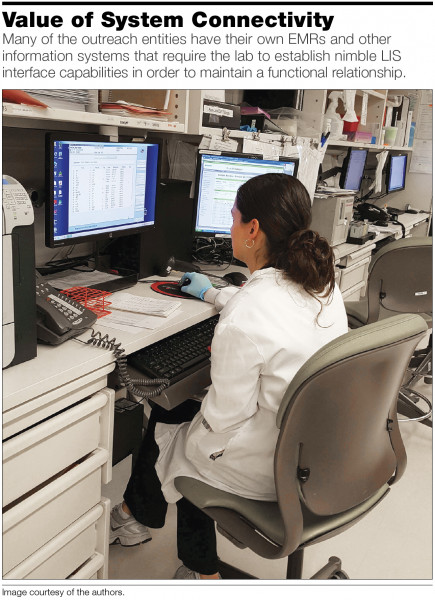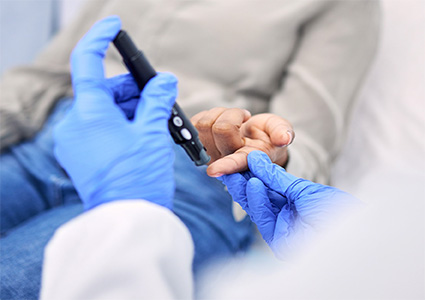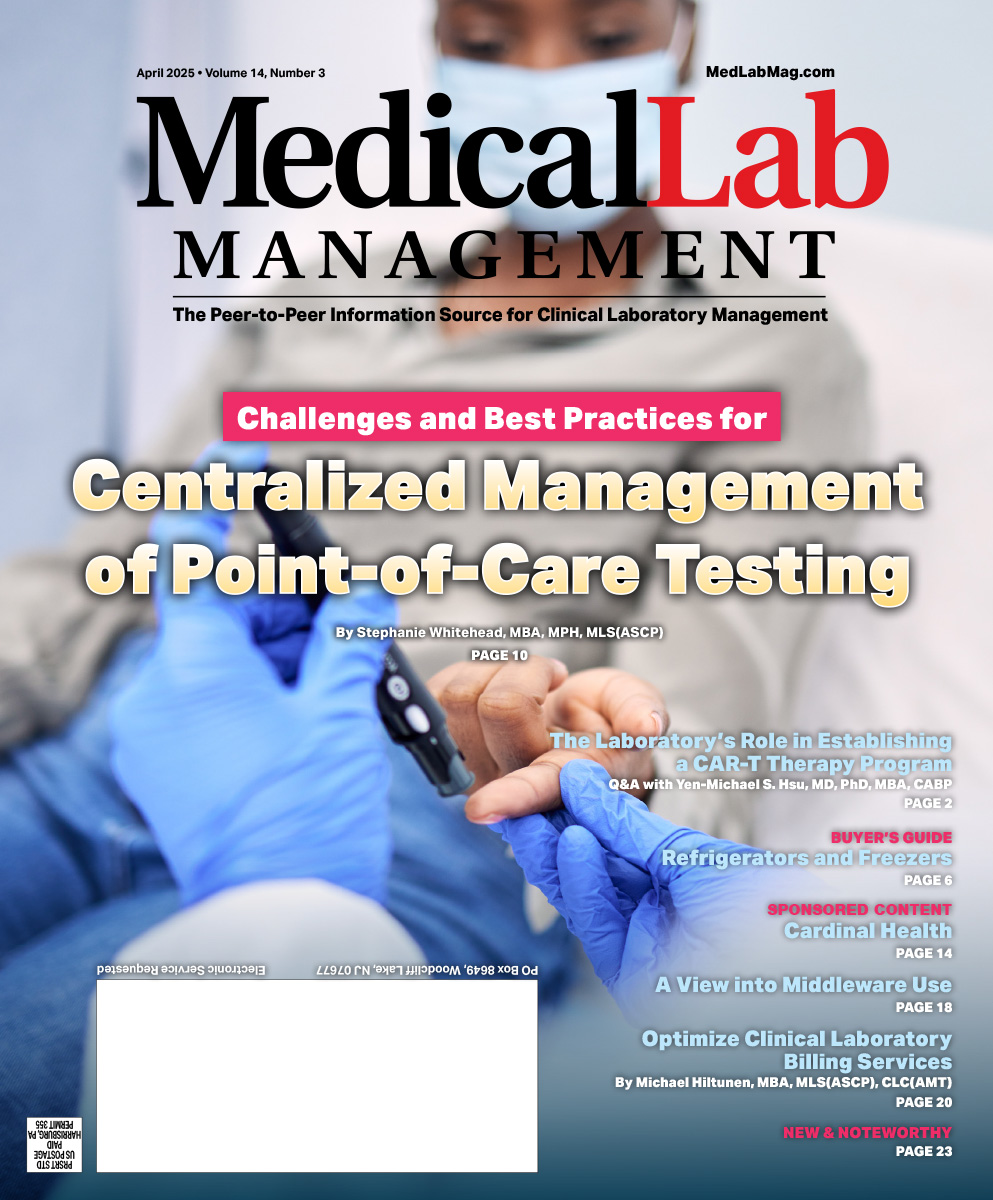- Show Menu
- Contact Us
- FAQs
- Reader Service
- Survey Data
- Survey Winners
- Testimonials
- Upcoming Events
- Webinars
Transforming the LIS
After using the same information system for approximately 20 years, with its attendant customizations and updates, senior leadership at The Valley Hospital (Valley)—a 451-bed, acute-care, not-for-profit hospital in Ridgewood, New Jersey—decided it was time to upgrade the entire system, hospital wide. Initially, four systems were considered, but after conducting a survey of all hospital departments, it was clear that the newest version of the system we had been using best suited the facility’s needs.
While this decision was deemed best for the entire hospital, clearly each department would need to manage the transition in unique ways, as was the case with the laboratory information system (LIS) aspect. The laboratory at Valley, which maintains just over two million billable tests per year, could not simply transfer data from a 20-year-old system to a new one, as many elements were obsolete and certain tests were no longer performed. Given this, laboratory staff deemed this an opportunity to completely rebuild the LIS from the ground up in a manner befitting our modern-day operations, and ensuring in the process that the new LIS could communicate flawlessly with the rest of the hospital, as well as the lab’s numerous outreach clients. As hospital facilities that practice outreach know, many of the outreach entities have their own EMRs and other information systems that require the lab to establish nimble LIS interface capabilities in order to maintain a functional relationship.

A Core Team
Once the hospital made the decision to upgrade the system in January of 2014, the first step for the lab was to assemble an LIS core lab team. The manager of molecular diagnostics/microbiology volunteered to lead the team, which consisted of the following representatives:
- Two staff, the core lab
- Four staff, pathology
- Two staff, the blood bank
- One staff, microbiology
- One staff, customer service
- Two staff, information services (IS)
In addition to spearheading all upgrade efforts in the lab, the head of the core team met regularly with the overall hospital information system core team, so that the lab’s interests were represented and hospital management was apprised of the lab’s progress.
Current State Assessment
The information system vendor set an implementation timeline and recommended that the hospital hire a consultancy firm to guide the facility through the entire upgrade process. Each department in the hospital had its own consultant. For the lab, the consultant sat in on most, if not all, meetings.
Among the more critical developments as a result of these meetings was the work done by our consultant and the LIS core team to assess the current state of LIS affairs. The consultant interviewed members of each lab department to determine how staff handled each and every lab function under the old system. Everything from registering patients, to specimen handling, to producing customized reports was discussed and analyzed so that the vendor could begin determining how the functions would be best accomplished under the new system.
The current state assessment took approximately 6 months to complete, but it was time well spent. The core team was trained by the vendor which took about 4 weeks. The rest of the time was made up of building and configuring the tests. Without a thorough and complete investigation into current practices, the likelihood of a successful implementation of a new system is limited at best.
Populating the LIS
Once the current state assessment was complete, the next step was to initiate the test information build for the new system, a phase that likewise required approximately 6 months to complete. Each lab department had to build the proper steps for each test performed, as well as the conditions of those tests. This included:
- Defining test parameters and possible results
- Determining whether the test can be ordered from the floor
- Identifying which staff members need to view test results
- Establishing how test results are relayed and received
- Affirming what reports and report styles are required
The core team then took all of this information and formatted it to fit within the new system. The six-month time period was necessary to tabulate and codify this information given the breadth of laboratory functions at Valley. The core lab, for example, includes chemistry; hematology; urinalysis; coagulation; point-of-care testing, including glucose meters; and the reference department. The reference department alone, which manages tests that are not handled in house, handles over 1,000 tests, so the test information build was time-consuming. Again, these preliminary steps are necessary in order to avoid costly interface breakdowns further downstream.
As usual, one of the most important factors in making this kind of build successful is involving end-users from the beginning. Not only because they are the ones who will actually execute on the new system and can best explain what they do on a daily basis, but also for obtaining their buy-in and fostering a positive sense of ownership for the project.
Validating and Training
Once the testing information build is complete, representatives from every department must test every function and interface to make sure the new system works as it should before it goes live. This frequently overlaps with some training of staff because trained staff members are required to test the new system. At Valley, the vendor rep and consultant first trained the core team on the new LIS, who in turn trained superusers in each lab department to help with the validating process. Subsequently, the superusers trained each employee in their department. Technologists received at least 2 hours of training, while anyone involved with registrations and/or billing received at least 8 hours. Departments that are open 24/7, such as the blood bank, had to train a superuser for each shift in order to maintain continuous and reliable coverage. This training phase took place in the approximately 3 month period prior to system go live.
In perhaps the most critical aspect of this phase, all relevant lab employees were given ample practice time on the LIS, utilizing numerous scenarios such that all end users could become as comfortable as possible with the new system.
Information System Go Live
The entire hospital went live on the new information system simultaneously, overnight, during the Memorial Day weekend of 2015. For a 4-week period following go live, the lab staff members most knowledgeable in the new system (ie, the LIS core team, superusers, vendor representatives, and consultants) were available on all shifts to answer questions and troubleshoot. This 4-week period was necessary given the number of per diem and part-time staff working in the Valley lab; knowledgeable staff members had to be available during all shifts in order to provide support until all non-full-time staff had cycled through. The troubleshooting team wore red vests so that anyone having an issue could spot them easily without leaving their workstation. These same red vests could be found in every department of the hospital during that time, as all hospital departments made adjustments.
During this time, one issue the lab had to resolve was the interface between the new LIS and the lab’s autofax system. The lab does a tremendous amount of outreach to area nursing homes and physicians’ offices, many of which fax in test orders and receive autofaxed results and reports. With a project of this scope, there are bound to be mistakes, and this interaction method was overlooked during the current state assessment or was not validated during the test phase, leading to confusion during the first few weeks after go live. We were able to work this issue out with the vendor rep and consultant, but in the interim, staff had to print orders and use courier services to transport results to some outreach clients.
Post-Go Live
After go live, a number of tasks remained:
- Completing conversions: The lab still had to convert the 20 years of data residing in the old system to the new system. Some departments took longer than others—the blood bank conversion took approximately 5 months to complete, whereas the pathology conversion is still ongoing. Completion by all lab departments is anticipated to occur no later than one year from go live.
- Customizing reports: Over the 20 years of its use, the former system became highly customized to accommodate our evolving needs. Many customized reports were not produced the same way by the new system and did not correlate with previous data. For the most part, these reports had been overlooked during the build because they are rarely produced (eg, once every 6 months or yearly). The process of recustomizing reports is ongoing, but likewise, the majority should be completed no later than one year from go live, while making sure that all reports are prioritized.
- Ongoing troubleshooting: Periodic issues continue to arise, although with decreasing frequency. As a recent example, a physician called to ask why his lab result had not arrived. Upon investigation, a discrepancy was discovered in the new system regarding where the patient was located in the facility when the sample was obtained. Under the old system, results were automatically sent to the physician; in this case, had he not called, we would not have known the result was never sent; the result went to the location of the draw rather than the physician’s office.
Lessons Learned
Although we are satisfied with our new system, if we had to repeat the process, there are certain things we would have done differently:
- Be wary of letting consultants do too much of the work. If the facility or lab decides to use outside consultants, be sure that key staff members work side-by-side with them such that once they leave, internal staff are able to seamlessly carry on. Our consultants performed much of the test information build on their own, and as a result, when they left 6 months after go live, our in-house analysts were not as knowledgeable as they could have been if they had been more involved from the beginning.
Instead of having in-house IS staff straddle between supporting the old and new systems, consider relegating consultants largely to supporting the old system and having in-house IS staff handle most of the work with the new system to maximize their ability to provide ongoing support.
- Set realistic expectations among staff. With this type of project, it is clear that intermediate successes will predicate a larger, more complete success. There can be a steep learning curve, and it takes time and patience to relearn new functions on a new system. Hold regular huddles with staff to inquire about frustrations and to provide encouragement. Likewise, focus on the future benefits of the system.
- Properly dedicate sufficient project time and staff. Changing information systems is a demanding and time-consuming process, but it can be streamlined. Most hospital labs cannot spare multiple staff to be dedicated to the task. Instead, staff members usually must find the time necessary to accomplish the transformation while executing their regular responsibilities. Given this, it is wise to work into those staff members’ schedules dedicated time for building, validating, and training on the new system, thereby allowing them focused time to remain undisturbed.
- Continue to customize. Given that every lab is unique, resist the temptation to accept basic vendor content if it does not work for your lab. The more time and effort dedicated to this at the onset, the less troubleshooting and rework will be required later. Everything can and should be customized because every lab has different needs.
Moving Forward
Now, 9 months after going live on the new system, the managers of all of the laboratory departments, the outreach liaison, and the lab director continue to meet every 2 weeks to address any questions and issues that arise, such as whether a new interface is required for a new piece of lab equipment.
Overall, the lab and hospital are highly satisfied with the new system. The lab has far less paperwork with which to contend because most reports now require us to print fewer documents. The new system is more user-friendly than our previous one, functioning more as a Windows-based product that our staff is familiar with. Although the 2-year process was arduous at times, the new LIS has improved efficiency and workflow, which ultimately improves our ability to provide superior care for our patients.

Lawrence J. Bologna, MBA, MS, MT(ASCP), FACHE, is director of laboratory services at the Valley Hospital in Ridgewood, New Jersey. He has over 35 years of clinical lab experience, including multi-site management, integration of lab services, and technical consulting for physician offices.

Doreen Atlak, MS, MT(ASCP)BB, is the blood bank supervisor at Valley where she has worked for over 20 years, including the first hospital-wide information system implementation in 1995.

Arceli Baluyot, MS, BS, MT(ASCP), is a project specialist at The Valley Hospital. She has over 20 years of both information systems experience and clinical laboratory experience, and is an active member of Medical Users Software Exchange (MUSE).

Kathleen Gerhardt, MS, MT(ASCP)SM, is the manager of microbiology and molecular diagnostics at The Valley Hospital. She has over 20 years of clinical microbiology experience.

Marlena Messyasz, HT(ASCP), is the manager of the histology/cytology department at The Valley Hospital. She has over 20 years experience in histology practice.

Julianne Shaw, MT(ASCP), is a registered medical technologist in The Valley Hospital Core Laboratory. With 3 years experience as a generalist in the core laboratory, Julianne also serves as coordinator of the chemistry portion of the Medical Laboratory Science Internship Program at The Valley Hospital.
Like what you've read? Please log in or create a free account to enjoy more of what staging.medlabmag.com has to offer.








